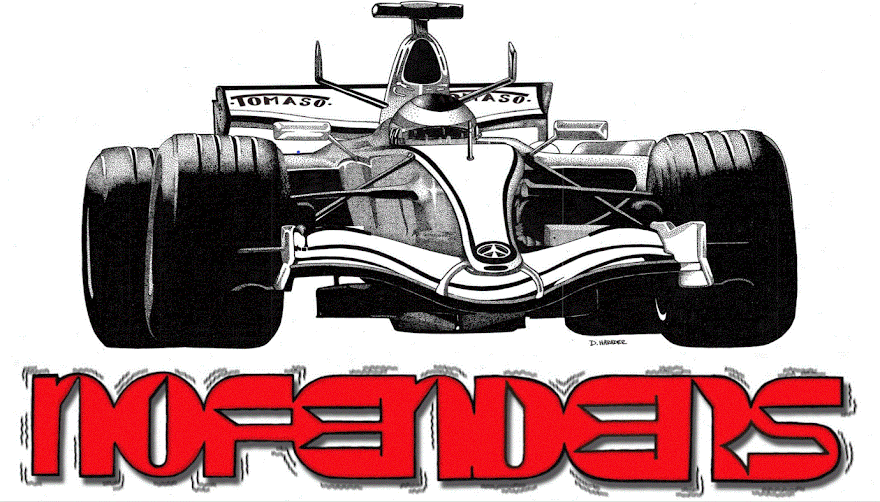Following Nakajima’s lead, several more Japanese
drivers competed in F1, beginning in the late 1980’s thru the next two decades and beyond, with Aguri Suzuki
becoming the second full time Formula 1 driver in 1988.
Ironically, I had the pleasure of witnessing Aguri-san
(Aguri Suzuki) walking into the paddock at Phoenix in 1989. Suzuki was accompanying some
“dude” named “A-Ayrton” (Senna) and was totally ignored by the fans present.
Little did I know that Suzuki was to become the first Japanese driver to ever stand
upon the podium one year later in Suzuka.
While Nakajima soldiered on with the fleeting
Lotus team before finishing his career with a two year stint at Tyrrell, Suzuki
spent the majority of his F1 career with the “Privateer” Larrousse outfit, followed
by stints at Zakspeed, Ligier, Footwork and Jordan before retiring in 1995.
Japanese driver involvement in Formula 1
reached it’s zenith in 1994 with four drivers contesting the championship.
Newcomers Ukyo Katayama, Taki Inoue and Hideki Noda joined Suzuki on the grid.
Katayama had actually joined the F1 circus as
Suzuki’s replacement at Larrousse in 1992 and reportedly was one of Japan’s most eccentric drivers, having gone to Paris to compete in
European racing! As well as breaking his neck and both legs in a junior
formula.
Nevertheless Katayama planned his comeback
immediately and ultimately found his way into Formula 1. After his brief stint
at Larrouse, Katayama enjoyed another four seasons in Formula 1 with the fading
Tyrrell team.
Inoue and Noda both broke into F1 with the
Simtek Grand Prix team, which unfortunately faded from the grid at the end of
1994 largely due to the tragic loss of Roland Ratzenberger a day prior to
“Black Sunday.” (Imola; May 1, 1994)
In its struggles to operate the new team,
paying drivers were taken on in the later half of the 1994 season, hence Inoue
and Noda’s appearances.
After making a single start for Simtek in
1994, Takachiho (Taki) spend the full ’95
season with the Footwork team. But Inoue is best known for his bizarre
accidents, first being run over by a course car at Monaco while being towed back to
the pits. Then he was struck by an errant recovery vehicle being sent to
retrieve his broken down car in Hungary
and was sent flying!
Meanwhile Noda was a pleasant “chap” who made
three starts for Simtek at the end of the 1994 season with intentions of
returning the following season before the team went into receivership with
debts of $10 million.
Joining the revolving door of aspiring
Japanese Grand Prix drivers was Shinji Nakano in 1997, who spent two season’s
at Tyrrell.
Nakano was followed by the next great hopeToranosuke
“Tiger” Takagi who spent his first season in F1 as Shinji’s replacement at
Tyrrell (1988) before joining Jos “The BOSS” Verstappen for his second and
final season at the faltering Arrows Grand Prix team
After a brief respite, while Nakano and Takagi
plied their trades stateside in Champ Car and the IRL, Japan’s next
rising star burst onto the scene in 2002 with Eddie Jordan. As Takuma Sato
capped off his rookie campaign with a fifth place points paying finish in Japan before
being dropped from Jordan Grand Prix.
Sato then took up refuge as BAR Honda’s test
driver in 2003 before replacing Jacques Villeneuve for that year’s Japanese
Grand Prix.
Taku-san ran two full seasons alongside
Jenson Button for BAR Honda before it was announced that he’d be jettisoned from
the squad in 2006. This move created such uproar in Japan that Honda effectively enticed
Aguri Suzuki into creating his Super Aguri F1 team as a satellite operation in
order for Sato to continue his Formula 1 career.
Takuma has done little to dampen his adoring
country’s admiration with solid performances aboard the ever improving “Super
Best Friends” chassis over the past two seasons.
With the launch of the Super Aguri F1 team,
largely backed by Honda, it was sought to run an all Japanese driver line-up
for the teams debut season. This saw relative unknown Yuji Ide as Sato’s
teammate, as Ide had raced for Suzuki’s Autobacs Racing Team Aguri (ARTA) in a
Nissan Silvia in 1999.
Yet after a spectacular shunt with Cristijan Albers, the
FIA demanded that Ide step down in favour of test driver Frank Montagny. Thus
effectively ending his brief Formula 1 career after only four starts, as the
FIA has also revoked his Super License
After a brief racing stint Montagny was subsequently
replaced by Sakon Yamamoto for the remainder of the 2006
season before being relegated to test driver status for the beginning of this
year’s championship.
But the tenuous financial outlook of the
Spyker F1 team saw Yamamoto’s suitcases full of Yen eagerly appreciated when
the Japanese driver was inserted as Albers replacement mid-season.
For the 2008 season Taku-san appears to be
the only Japanese F1 pilote with a secure future at "Super Best
Friends," aka Super Aguri F1, as Yamamoto most likely will be replaced after
the just completed sale of Spyker F1.
Meanwhile Williams Toyota currently has Kazuki Nakajima under contract as its test driver. Kazuki is the son of Satoru Nakajima and currently
competes for the DAMS team in GP2…
(This page was Updated on: February 20, 2016)
